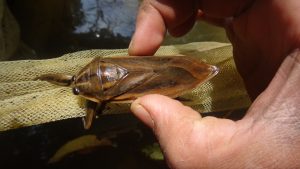…blog by Nikki Banfield, Buglife Communications Officer. Originally written for BBC Wildlife in August 2023.
Here in the UK we tend to think of insects as being quite small, with the ones we would consider our largest, whether that be in length, wingspan or by weight being a pretty impressive sight.
The largest UK beetle is the Stag Beetle (Lucanus cervus) measuring in at 35-75mm long, including their jaws/mandibles and weighing a chunky 2-6 grams. Our largest moth, the Emperor Moth (Saturnia pavonia), can have a wingspan of up to 80 mm and our longest insect is probably the non-native, naturalised Unarmed Stick Insect (Acanthoxyla inermis), measuring up to 125mm in length.

Other insects in the UK that could fall into the UK’s largest insect category might be the Hornet Robberfly (Asilus crabroniformis) our largest species of fly which can reach up to 28mm in length; the noisy and incredibly clumsy Cockchafer (Melolontha melolontha) a beetle growing up to 30mm in length or maybe even the Emperor Dragonfly (Anax imperator) which averages around 78mm in length with a 105mm wingspan.
However, these UK “giants” of the insect world are pretty small when you start to dig a little deeper, by both global and historical standards.
Determining which insect is the largest is a tricky endeavour; the word large will mean many things depending on who you talk to. It could be the length of an insect, or the weight, wingspan maybe even the general bulk. Consequently, we’re going to have a look at a number of different species which could fall into the world’s largest insect category and leave it to you to decide which you think comes out on top!
The world’s longest insect is currently the Giant Chinese Stick Insect (Phryganistria chinensis); discovered in China as recently as 2014. The wild collected adult female phasmid (stick insect) measured 624mm in length with legs outstretched, but was surpassed by one of its captive bred young that reached 640mm in length! The Jungle Nymph (Heteropteryx dilatata) of Malaysia, does not reach the same impressive lengths as its Chinese cousin but is one of the chunkier “sticks”, and often cited as one of the heaviest, reaching up to 65g in weight.

The Blue-winged Helicopter (Megaloprepus caerulatus), a damselfly from the Central American rainforests, is the largest living member of the dragonfly and damselfly order, Odonata. With a body length of around 130mm and a wingspan of 190mm, it’s almost twice the size of the UK’s Emperor Dragonfly and makes an easy meal of its chosen prey, orb-weaver spiders, which it plucks straight from the spider’s web.
But by historical standards this is still pretty small. If we go back in time, nearly three hundred million years in fact, the largest known insect was a predator resembling a dragonfly, but only distantly related to them; Meganeuropsis permiana. This prehistoric insect had a body around 430mm long and a wingspan of an incredible 710mm (that’s nearly 1 metre or 2.5 feet!). Their maximum body mass is uncertain, with estimates varying between 34g and 240g.
Back to the modern day, the Queen Alexandra’s Birdwing (Ornithoptera alexandrae) is the largest species of butterfly in the world. It is found in Eastern Papua New Guinea and adult females can have a body length of around 80mm and a wingspan slightly in excess of 250mm.
The Little Barrier Island Giant Wētā (Deinacrida heteracantha) could also appear in the world’s largest insects list. Endemic to New Zealand, where it survives only on the Little Barrier Islands and some predator free conservation areas it has been translocated to, this relative of the grasshopper can measure up to 100mm in length. It is often cited as the heaviest insect in the world with one captive female reaching a mass of 71g.

There are probably a few other insect that deserve a mention whilst we’re talking “large”; they may not be the largest, but they are still pretty impressive!
Many beetles reach great sizes but the Royal Goliath Beetle (Goliathus regius) is amongst the largest, measuring up to 115mm in length. Found in western equatorial Africa this “goliath” of insects primarily feeds on tree sap and fruits and despite its large size it can fly well. Goliath beetle larvae get even bigger and are capable of growing up to 250 millimetres in length and reaching weights in excess of 100 grams!
The longest beetle awards could go to the Mexican/South American Hercules Beetles (Dynastes hercules). Thanks to its great “horn” it can measure up to 181mm in length, and the Wallace’s Long-horn Beetle (Batocera wallacei) from New Guinea can grow to about 266mm in length, with around 190mm of this being antennae.

Giant Water Bugs (Belostomatidae), are a family of freshwater hemipteran insects, or true bugs. Occurring worldwide, but with most species in the Americas, Australia and Asia, they are typically found (as their name would suggest) in or around water; freshwater streams and ponds. The largest Giant Water Bugs can grow to more than 120mm in length.
The largest lacewing is the Blue Eyes Lacewing (Nymphes myrmeleonides), an Australian insect found in New South Wales and Queensland. This lacewing can measure up to 40mm in length and have a wingspan of around 110mm. As with dragonflies and damselflies, similar species flew the earth during the Jurassic period and also grew incredibly large. Partially preserved Makarkinia adamsi fossils suggest that this ancient species had wings between 140-160mm in length!
Insects come in a variety of shapes and sizes with new species being discovered on a regular basis, both living and fossilised. Given that the Giant Chinese Stick Insect, despite its size, was only detected in recent years, is it possible that the world’s largest insect is yet to be discovered?
Main Image Credit: Stag Beetle behind a leaf © Martijn Nugteren (Luminar Bug Photography Awards 2020 Beetles 2nd Place winner)